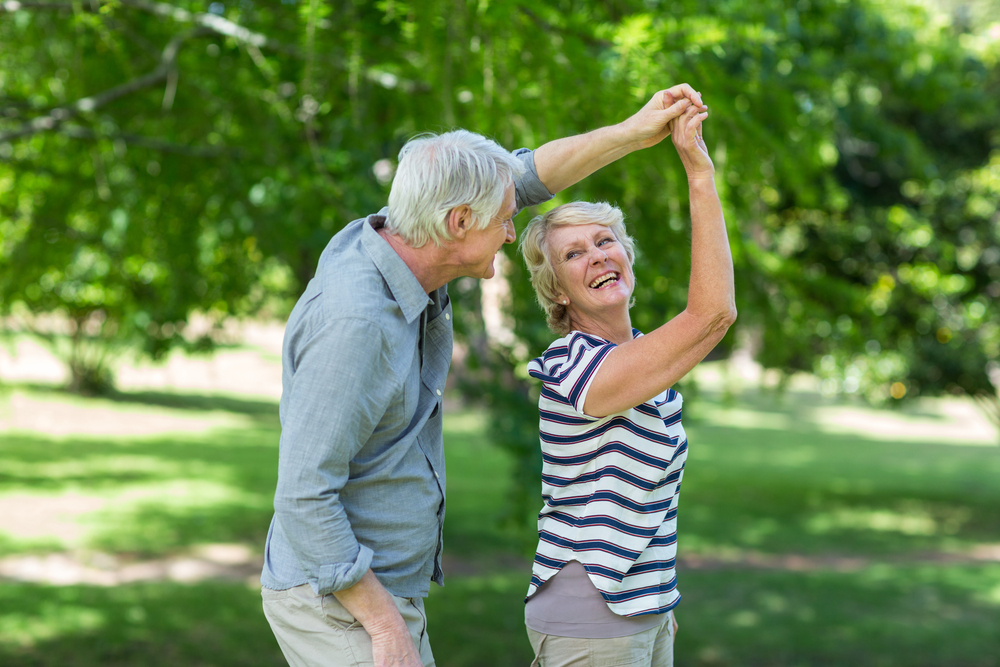
To mark National Mental Health Awareness Month in May, sign up a senior citizen in your life for ballroom dance classes to improve their mental health and stave off depression and loneliness.
National Mental Health Awareness Month is a time to raise awareness of people battling mental health demons and to reduce the stigma of mental illness. It’s also a time to encourage people who are suffering from mental health concerns to get help. Every May, organizations and hospitals across the nation launch public service campaigns, local events, and health screenings to raise awareness for mental health. National Mental Health Awareness Month was started in 1949 by Mental Health America, the nation’s leading community-based nonprofit dedicated to addressing the needs of those living with mental illness and promoting the overall mental health of all.
Senior citizens are particularly vulnerable to mental illness. At least 20 percent of adults over the age of 55 suffer from a mental health disorder, including anxiety, mood disorder, and cognitive impairment, according to the Centers for Disease Control. At least 7 million adults in the United States over the age of 65 are impacted by depression, and older men have the highest suicide rate of any age group. The outbreak of COVID-19 exacerbated mental health concerns of the elderly by forcing them to isolate themselves from their loved ones and stay home to keep healthy. As more people get the vaccine and social distancing guidelines ease, elderly Americans are gaining the courage to resume normal activities and reunite with family. Social and emotional support can help reduce mental illness and depression in the elderly, as well as bolster physical well-being, the CDC reports.
Fred Astaire Dance Studios believes life is better when you dance. Not only does dancing improve your physical health by providing a low-impact aerobic workout, but it also bolsters your mental well-being. Dancing is the perfect combination of physical activity, social interaction, and mental stimulation. Here are just a few of the ways dancing can help improve the mental health of our nation’s seniors.
Ease depression and anxiety. One of the best ways to help prevent depression and anxiety is to exercise regularly. Exercising releases endorphins that naturally inhibit negative thoughts and anxiety. Dancing allows people at all ages and stages of their life to get in shape. It burns calories to improve cardiovascular fitness and can increase flexibility.
Boost brain function. Many seniors experience memory issues, which can instill fear and anxiety. Learning complicated dance steps requires people to put their brains to work and sharpens the mind. Studies show dancing can help prevent dementia in seniors, the New England Journal of Medicine reported. Dancing requires couples to use decision-making skills, which can help give them a sense of control they may be lacking as they age.
Raise self-esteem. Accomplishing the steps to a fast-paced salsa or swing can help improve self-esteem and increase confidence.
Ease loneliness. Ballroom dancing is a social activity. Attending a regular dance lesson will ensure seniors get out of the house and onto the dance floor. Spending time with other people goes a long way to improving mood and easing loneliness.
Check out these senior citizens having fun on the dance floor.
The seniors at South Bay Living and Retirement in Wakefield, Rhode Island, took time to film a music video to entertain viewers and showcase their dance moves.
A 71-year-old dancer stuns the judges on “America’s Got Talent” with her ballroom dancing skills.
Here’s an uplifting compilation of seniors enjoying moving to the music.
To help raise awareness of mental health, Fred Astaire Dance Studios encourages you to give the senior citizen in your life the gift of dance. Contact your local studio to learn about introductory offers and class schedules.

